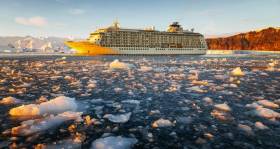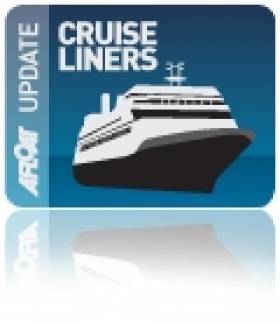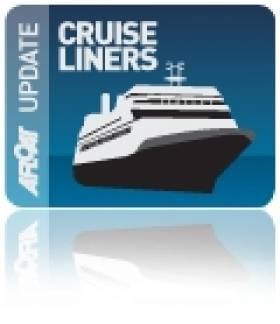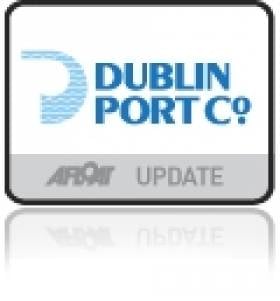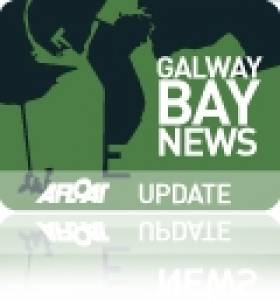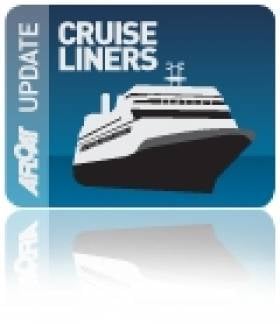Displaying items by tag: The World
The World: Wealthy Owners Pay $2m - $15m for a 'Home' on Ship Set to Visit Killybegs
The World which is one of the most unique ships to ever visit Killybegs is set to dock at the Donegal port next month.
The largest purely residential ship on earth is paying its first ever visit to this county.
On board will be some of the super-rich owners. In essence, this is a vessel with 165 homes onboard - made up of 106 apartments, 19 studio apartments, and 40 studios - that are all privately owned.
Occasionally, some of the homes come onto the market and can typically fetch anything between $2 million - €15 million.
On top of that, there is also an annual charge.
The World continually circumnavigates the globe visiting some of the most intriguing destinations and taking the time to explore location in depth, with longer stays in port than most cruise ships.
To read more of The World's two week long visit that is to include other Irish ports of call, DonegalLive has more to report.
The World of Residences at Sea Revisits Dublin's Changing Commercial City Scape
#TheWorld - The World revisits Dublin where the capital continues to change, notably in the ongoing developing 'Docklands' financial quarter, a stone's throw away to where the largest private residential ship on the planet is docked, writes Jehan Ashmore.
Prior to the arrival in the Irish capital, The World operated by Residences at Sea, had sailed from Lerwick, capital of the Sheltands and the Norwegian fjords. In addition in the Arctic Ocean as far north as Spitsbergen, the largest and only permanently populated island of the Svalbard archipelago. The territory belongs to Norway.
On this Irish visit, The World which arrived on Monday as part of a four day visit, docked along the North Wall Extension, next to the Tom Clarke toll lift-bridge. The bridge formerly known as the 'East-Link' is where the working port meets the financial services quarter located in the old 'Docklands'.
It is here along the Docklands northern banks of the Liffey's waterfront is where the Central Bank of Ireland relocated to new headquarters in 2017. The commercial property occupies part of a bustling high-rise cityscape which can easily be afforded to those observing from the aft decks of The World.
The 43,000 gross tonnage luxury ship is home to an exclusive elite of just 165 'Residences' each with a private veranda. Residents and guests have an exclusive environment and lifestlye to match that exists nowhere else on earth, but set on board The World that continuously circumnavigates the globe seven seas, spending time in the most exotic and well-traveled destinations. Only the very well heeled get to the experience the ultimate in luxury by being able to return on board to a place that is regarded as home.
So what has The World to offer, firstly the private yacht and luxury vacation home provides those you can, to enjoy the novelty while at sea and visiting numerous ports of call. Subject to the port of call, be it a secluded bay, on marina days sailing and kayaking is organised from The World's 'marina' platform, which lowers from the stern of the Bahamas flagged vessel to faciliate easy access to the water.
Also residents experience the only regulation-size tennis court at sea in addition to be able to hone skills on the outdoor putting greens with a resident professional. Or to take practice using 80 famous courses through a state-of-the-art golf simulator.
As for fine dining, there is a choice of six unique restaurants, Michelin-level or perhaps better still? a meal prepared in your own private Residence!
If that World is not enough!... among the amenities, residents can relax and catch the latest film in Colosseo, The World’s full-size theater. Asides the silver-screen, those can dive into a great novel or catch up on the latest global news in the study or try a hand by taking up billiards.
According to The World's itinerary for the period July to this month of September, the ship is next to call to Cork (Cobh) cruise terminal for overnight calls (21-23 September) in addition a port of call for the West Country in the UK, the Channel Islands and more sunny climes along the coast of Iberia.
Earlier this year The World made maiden voyages to several Brazilian destinations, proving that certain destinations had yet to be ticked-off by the 2002 built ship. As for further forthcoming exotic places to visit, The World rounds out the year in the middle of the Atlantic. This is to involve visiting volcanic islands of Ascension and St. Helena (see: the island's last 'RMS') as previously reported on Afloat.ie
The World is to welcome the first light of 2019 on the southern tip of Africa. Following this introduction of the New Year, Residences at Sea have set out an extraordinary journey that will take the residents to 91 ports of call across the Indian Ocean, South East Asia and China.
Mega Yacht Sets New Record For Most Southerly Navigation
#Offshore - A giant private yacht has broken the record for the most southerly navigation, reaching 78°43.997’ S and 163°41.421’ W at the Bay of Whales in Antarctica’s Ross Sea.
The World, a 43,188-ton yacht with 272 crew and carrying 145 residents and guests, recorded the new polar record – the furthest any vessel has ever sailed – at 10.41 ship’s time (New Zealand time) on Saturday 28 January.
The mega yacht, which circumnavigates the globe every two to three years, is currently undertaking a 22-day expedition of the Ross Sea, including 12 days in Antarctica assisted by EYOS Expeditions led by Rob McCallum.
Commenting on the new record, The World’s Captain Dag H Saevik said: “When we designed this remarkable expedition to the Ross Sea with our residents, that has taken two years of preparation, we hoped that with the right conditions we might be able to reach the ice shelf and set a new record for the most southerly navigation.
“This voyage of more than 5,000 nautical miles has taken us to the most isolated area of the world. Explorers like Amundsen, Shackleton and Scott have always been driven to explore the furthest boundaries. However, not many people get to travel to the end of the earth from their own home.”
Few vessels have made the journey to this remote part of Antarctica. In February last year, the polar expedition vessel Akademik Shokalskiy reported reaching 78°43.971’S.
The World Berths Bringing Bali-Beds Back to the Capital
#TheWORLD – This morning The World berthed in Dublin Port beside the East-Link Toll Bridge, having made calls to Belfast, Galway and London-Derry in this year of the UK City of Culture, writes Jehan Ashmore.
The exclusive residential vessel of 43,188 tonnes is operated by Residences at Sea. The on board community which own one or more of the 165 private residences between them is spread across the 196m long ship and with facilities on 12-decks.
She has visited Dublin Port several times and on this occasion the vessel is to stay in port for three nights and depart in the early hours of Sunday morning.
Click and scroll across the picture gallery to reveal The World's luxurious facilities which offer many different experiences. Among the various amenities is the swimming pool, a putting green, marina sports platform, the spa, a cigar club and regatta bar plus a choice of dining options. After an active day on board or an excursion ashore what about taking to an open-air Bali-bed!... and under a balmy starry night.
An example of the residents private quarters are the Two-Bedroom Apartments which in the majority have a fully-fitted kitchen, though residents can also dine out in the ships restaurants with a range of cuisine to suit many tastes.
On returning to these two-bedroom apartments, residents can relax in the spacious living and dining areas. The apartment has en-suite bathrooms in both the master bedroom and guest bedrooms. As the ship visits numerous exotic ports and locations, the owners can watch the World go with immediate accessibility with use of the ample veranda space.
The Bahama-flagged The World was launched over a decade ago at the Norwegian shipyard of Fosen Mekaniske Verksteder AS. She is capable of operating her twin 7,400HP direct injection turbo-charged engines from full ahead to full astern in just 50 seconds making her a highly manoeuvrable ship. The turbo-charged engines produce a speed of 18.7 knots.
Largest Residential Cruise Liner is Galway Bound
#CruiseLiners - The world's largest residential cruise liner is set to visit the City of the Tribes next week, according to the Galway Independent.
The floating town known as The World is expected to arrive in Galway Bay next Monday 8 July for a single night's stay after a similar stop this morning at Belfast and later this week at Derry.
Distinct from other cruise liners that ply the oceans, The World comprises a residential community of some 130 families who between them own the 12-deck, 200-metre-long vessel.
Galway Harbour Master Captain Brian Sheridan described The World's visit as "a great opportunity to showcase the city and the region to its passengers and a welcome economic boost" - despite the ship being too large to enter Galway's inner harbour.
Providing berthing space for the modern generation of cruise ships is one of the goals of the planned expansion of Galway Port, though it emerged this week that the planning application had still not been submitted to An Bord Pleanála.
The Galway Independent has more on The World's visit HERE.
#TheWorld – Residensea's 41,000 tonnes ultra-luxury The World, the only private residential community-at-sea based ship berthed in Belfast Harbour this morning, writes Jehan Ashmore.
Residents on board the 644ft ship may travel the globe without ever leaving home, as they own one or more of the 165 private residences. For an example of the accommodation take a peek of a two-bed apartment.
Since her launch in 2002 continuously circumnavigated the world visiting the most exotic locations as well to calling to well-travelled ports.
Belfast Harbour which celebrates its 400th anniversary this year is to welcome a record 60 cruiseship calls, bringing over 100,000 visitors to the city and to tourist hotspots throughout Northern Ireland.
The World berthed in the Pollock Basin of the port, though most larger vessels dock alongside Stormont Wharf. The port is to increase business in this sector with a £7m investment purpose-built cruise terminal which will see such cruiseships moor instead on the south quays of the Lagan and nearby to the Titanic Belfast Visitor Centre and Quarter.
Among the cruise line operators visiting Belfast Harbour in 2013 are Princess Cruises, Holland America Line, Celebrity Cruises, MSC, Thomson, Fred Olsen Cruise Line and Saga Cruises.
The first caller of the season was by another ultra-luxury caller Hebridean Princess which visited in April.
#Cruiseliners -Discovery not only has the distinction of becoming the first cruise caller to Dublin Port in 2013 but also under the brand of Cruise & Maritime Voyages, writes Jehan Ashmore.
The 700 passenger capacity vessel docked today at Ocean Pier having departed her homeport of Avonmouth yesterday for the start of this year's cruise season.
Discovery of 20,000 tonnes and built in 1972 will be followed by fleetmate Marco Polo with a call on Friday to Dublin Port where the port is to welcome another record-breaking season with around 100 calls, with the Gathering being a major visitor draw.
As previously reported on Afloat.ie the giant 2010 built $547m MSC Magnifica of 95,000 tonnes which has more than 1,500 cabins accommodating a maximum 3,223 passengers, is to make her maiden 'Irish' call in late May.
The 294m 'Musica' class vessel is a larger fleetmate of Mediterranean Shipping Company's MSC Lirica, which last year also made a debut docking to Dublin Port and Cobh.
Other large callers to Dublin Port are Caribbean Princess, Celebrity Infinity and Queen Elizabeth which made her inaugural Irish call in 2011.
In addition The World, which also makes a return to the capital following her first ever call to Galway Harbour with an 'anchorage' call in early July.
Last year approximately 90 individual cruise calls were made to the capital which welcomed 100,000 passengers and brought between them €35-50m to the local economy.
With the increase in calls during 2013, the Dublin Port Company is to address future demand through its Masterplan 2012-2040, with a proposed new dedicated cruise terminal completed by 2015.
The facility would be sited along North Wall Quay Extension close to the East Link Bridge.
"The World" Looks Forward to City of the Tribes
#GALWAY CRUISECALLS –The World, the exclusive ultra-luxury residential passenger ship is to open the 2013 cruise season to Galway Harbour when she is to make a two-night visit during July, writes Jehan Ashmore.
In addition three cruiseships are also to call during the summer months from operators Compagnie du Ponat, Holland America Line and V-Ships. The port in recent years has raised its international profile considerably since the hugely successful hosting of the Volvo Ocean Race twice.
The Norwegian built The World was launched in 2002 and operated by ResidenSea. She is to anchor off Galway Harbour close to Mutton Island. Tenders will transfer passengers ashore as the 43,188 tonnes ship is too large to be accommodated in the single (Dun Aengus) dock.
Her arrival is to generate an economic boost to the city, where the port claim conservatively that 35 cruise liners could call on an annual basis coupled with a visitor spin off of €9.9m.
Galway Port Company Harbour master Captain Brian Sheridan has commented that The World can be accommodated in the proposed new port where the 196m long ship would be able to moor alongside and allow passengers to stroll ashore.
Bremen Visits Galway
#GALWAY CRUISE CALL– Following last month's first cruise call this season of Silver Explorer to Galway Docks, the city of the tribes welcomed the Bremen yesterday, writes Jehan Ashmore.
Unlike the Silver Explorer, operated by Silverseas Cruises, which transited through the narrow entrance into Dun Aengus Dock, the Bremen (1990/6,752grt) made an anchorage call offshore. The latter vessel which is operated by Hapag-Lloyd, has a four-star ranking according to the Berlitz Guide to Cruising 2012.
The small expedition ship takes her 164-guests who in comparison are served by a large crew numbering 100. The vessel visits some of the most beautiful and remote regions in the world which has included visiting both the poles at the Artic and Antarctica.
On this particular cruise, she had called to Kilronan, Inishmore on the Aran Islands and is currently underway heading for Tory Island.
The presence of the Silver Explorer, previously Prince Albert II, made for an interesting experience as Galwegians witnessed the vessel navigate skillfully through the tight confines of Dun Aengus dock system.
A further six cruise calls are scheduled, the next been Cruise & Maritime Voyages (CMV) Marco Polo, the classic cruiseship with her liner heritage is to make the port of call in July.
Dublin Port Outlines Plans for First Dedicated Cruise Terminal
In order to facilitate this growth, the draft proposes switching existing berths used by large cruiseships away from unattractive cargo-docks in Alexandra Basin's West and East and at Ocean Pier. Up to three alternative locations were examined and the port agreed that the option identified in the Dublin City Council's Area Plan of the North Quay Extension is the optimum location.
Before any such development, it would require relocating an existing roll-on roll-off terminal (No.3), which is currently in use by P&O Irish Sea for their Dublin-Liverpool service. The company operate three sailings daily on the central corridor route.
The new facility could accommodate two large cruise ships simultaneously and would be much larger than the 43,524grt The World, the luxury resort vessel operated by Residensea, which docked at the North Wall Extension in 2010 (for report click HERE).
The location is on the doorstep to the East-Link Bridge and the neighbouring O2 Arena and Point Village developed by Harry Crosbie, who called for the relocation of cruise callers to be sited upriver.
According to the draft, the closer proximity to the city-centre would provide a stronger presence and a more accessible link with the city. It would also avoid the unnecessary longer bus transfers between cruise berths and visitor attractions in the city-centre and locations in counties Wicklow and Meath.
Construction of facilities for a cruise terminal would expensive as it will involve new quay walls capable of accepting large cruise vessels but this could only be done after dredging the channel to a depth of 10.5m.
The facilities of the terminal are to incorporate a reception, tourist information and interpretive centre, a dedicated entrance for pedestrians, coaches, vehicles and traffic management measures would be implemented.
In addition the site would also require the expensive exercise in re-locating ESB underwater high-voltage cables. The initial costs suggest to develop new terminal facilities and associated works would be in the region of €30m.
Dublin Port Company, state that due to the relatively low revenues generated by cruise ships, such an investment alone could not be justified, however, they could part-fund the development but additional funding would be required from other sources.
- Dublin Port
- Dublin Port Company
- The World
- Cruise Liners
- Harry Crosbie
- Port of Dublin
- Ports and Shipping News
- Point Village
- P&O (Irish Sea)
- Cruise Liner news
- Ocean Pier Dublin Port
- O2 Arena
- EastLink bridge
- Dublin Port draft masterplan
- DPC
- North Wall Quay Extension
- Residensea
- Dublin Port Terminal 3
- Alexandra Basin Dublin


























